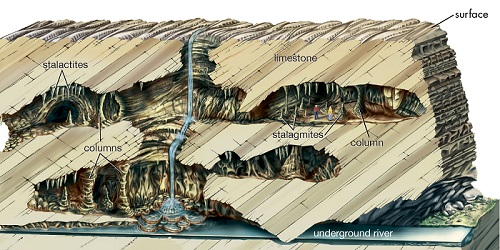- Filter By :
- Geography
- History
- Indian Heritage & Culture
- Indian Society
-
Q. Explain the various types of landforms formed under Karst topography.
08 Apr, 2021 GS Paper 1 GeographyApproach
- Start the answer by defining codes of ethics and codes of conduct separately.
- Discuss the major differences between the code of ethics and the code of conduct.
- Conclude suitably.
Introduction
The term karst describes a distinctive topography that indicates dissolution (also called chemical solution) of underlying soluble rocks by surface water or groundwater.
Karst, terrain usually characterized by barren, rocky ground, caves, sinkholes, underground rivers, and the absence of surface streams and lakes. This topography is commonly associated with carbonate rocks (limestone and dolomite).
Body
Formation of Karst Topography or its Cycle of Erosion
- Conditions that promote karst development are well-jointed, dense limestone near the surface; moderate to heavy rainfall; and good groundwater circulation.
- Limestone (calcium carbonate) dissolves relatively easily in slightly acidic water, which occurs widely in nature.
- Rainwater percolates along both horizontal and vertical cracks, dissolving the limestone and carrying it away in solution.
- Limestone pavements are produced by the removal of surface material, and the vertical fissures along joints are gradually widened and deepened, producing a grooved and jagged terrain.
- As it flows along cracks underground, the water continues to widen and deepen the cracks until they become cave systems or underground stream channels into which narrow vertical shafts may open.
Karst Landforms
- Sink Hole: If a cave becomes large enough and the top extends close enough to the surface, the top collapses. This produces depressions called sinkholes, which are among the most characteristic features of karst topography.
- Karst Window: When a number of adjoining sinkholes collapse, they form an open, broad area called a karst window.
- Stalactite: A portion of the roof hangs on the roof and on evaporation of water, a small deposit of limestone is left behind contributing to the formation of a stalactite, growing downwards from the roof.
- Stalagmite: The remaining portion of the drop falls to the floor. This also evaporates, leaving behind a small deposit of limestone aiding the formation of a stalagmite, thicker and flatter, rising upwards from the floor.
- Column: Sometimes, stalactite and stalagmite join together to form a complete pillar known as the column.
Conclusion
Karsts are found in widely scattered sections of the world, including the Causses of France; the Kwangsi area of China; the Yucatán Peninsula in the United States.
To get PDF version, Please click on "Print PDF" button.
Print PDF





